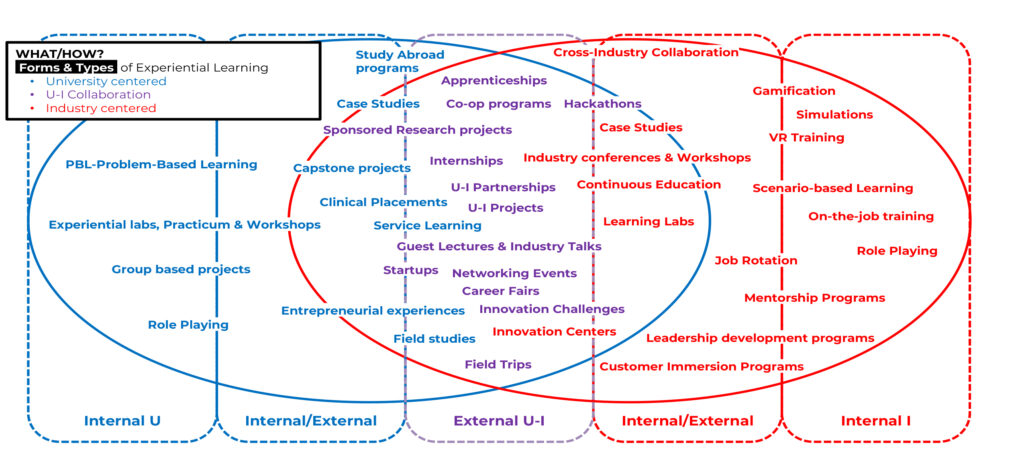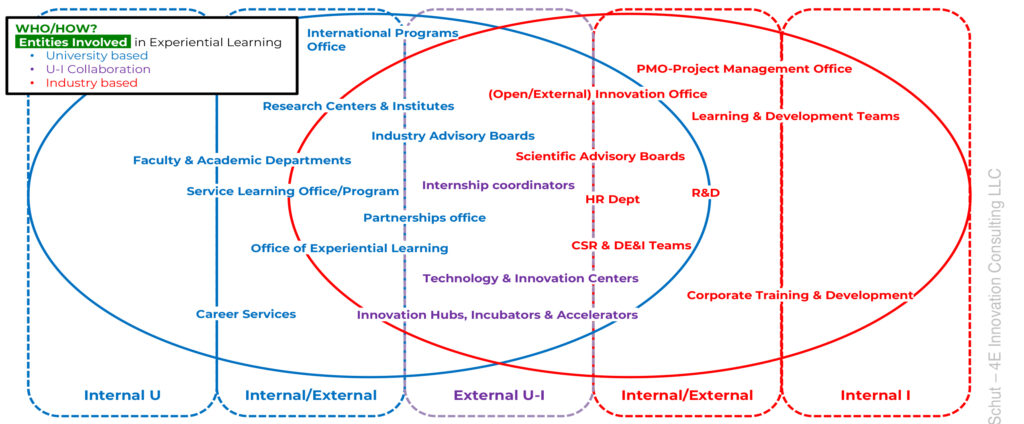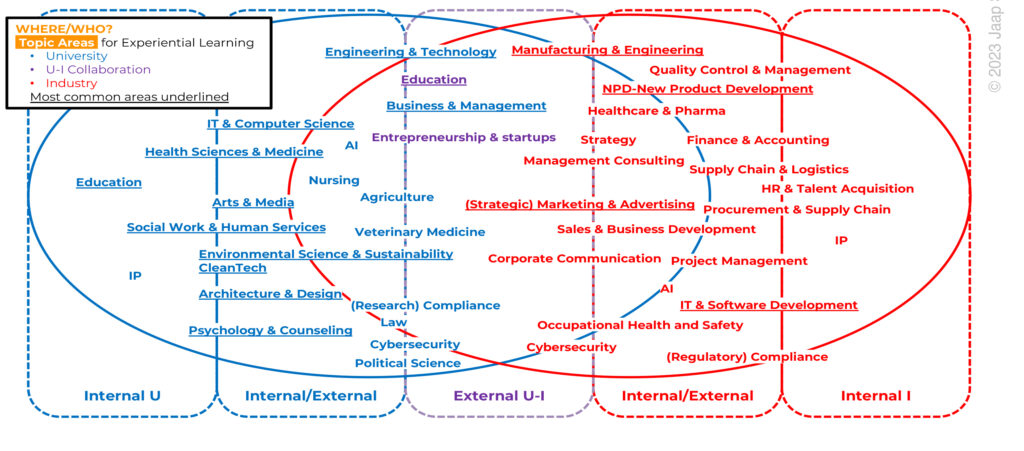Experiential Learning in University-Industry Collaborations
It is essential to forge strong university-industry (U-I) partnerships in preparing students for the challenges of the professional world and for the ever-evolving demands of our global economy and polarizing society.
The traditional boundaries between academic education (the classroom and the lab) and industrial and corporate application (the boardroom and the market) are rapidly dissolving, and the symbiotic relationship between universities and industries is gaining prominence, in which EL is occupying a central position, in this author’s opinion.
UI Collab operates at the intersection of academia and the corporate world, so in this blog post we will delve into a comparison of experiential learning as it is used in university, corporate, and U-I settings.
Starting with a definition, the pros and cons, and the didactic angle, we’ll then then look at practical aspects of EL in each setting based on a U-I mapping, and finish with my personal experience of EL, both as a subject and as a user of this great educational tool.
We hope that this post will help more people and organizations establish or improve their experiential learning practices, and benefit from its positive impact!
What is Experiential Learning?
Experiential learning is a pedagogical approach that emphasizes hands-on, practical experiences to complement theoretical knowledge. In this learning model, individuals actively engage in real-world experiences, reflect on those experiences, and integrate the lessons learned into their understanding. It transcends traditional classroom boundaries and fosters a deeper understanding of the subject matter, cultivates critical thinking skills, and nurtures the ability to adapt to complex challenges.
Why Experiential Learning?
The benefits of using EL are numerous for both parties.
Universities often profit from:
- Enhanced (holistic) learning outcomes
- Improved critical thinking skills
- Higher career readiness and employability
- Higher industrial/societal relevance of the curriculum
Industry usually benefits by:
- Increased access to emerging talent
- Better employee onboarding, engagement, and/or retention
- Improved skill development
- Refreshed innovation perspectives and top- and bottom-line growth
Challenges and hurdles to implementing and executing EL exist across the two domains.
Universities may struggle with:
- Resource and budget constraints
- Lack of industry contacts
- Balance between theory and practice: academic rigor vs. practical applicability
Industry might be constrained by:
- Time and budget constraints
- Strategic alignment and commercial relevance
Approaches to EL differ by organization.
Universities often center it around:
- Academic integration
- Curriculum design
- Diversity of instructional methods
Industry will focus on:
- Training programs
- Professional development
- Problem-solving oriented learning
While this comparison shows the differences between both organization types, one can also see the similarities, and observe that good U-I collaborations (the best practices of which can be found in various other blog posts by our UI Collab consultants) will actually remove many of these barriers by enhancing mutual understanding and leveraging U-I synergy.
Understanding Experiential Learning – Educational theory
The classic framework for categorizing educational objectives and learning outcomes is Bloom’s Revised Taxonomy. While not specifically developed for experiential learning, this framework has been the foundation for designing educational curriculum for many decades. Educators worldwide use Bloom’s Taxonomy to design and assess learning objectives and develop activities, assessments, and instructional strategies that align with specific cognitive levels. Its six levels, from the lowest to the highest, are:
- Remembering (Knowledge): Recognizing or remembering facts, concepts, or ideas.
- Understanding (Comprehension): Comprehending the meaning of information; interpreting, summarizing, and explaining concepts.
- Applying: Using acquired knowledge in new and concrete situations, using information in a practical and hands-on manner.
- Analyzing: Breaking down information into parts and understand the relationships between these parts.
- Evaluating: Making judgments about the value of ideas, information, or methods for a given purpose; assessing the validity, reliability, and effectiveness of information.
- Creating (Synthesis): The ability to combine elements to form a new, coherent whole. This highest level of Bloom’s Taxonomy involves creating something new, whether it is a product, idea, or solution.
When zooming in to experiential learning itself, the most referred to theory is Kolb’s ELT (Experiential Learning Theory), which identifies four phases in the experiential learning cycle:
- CE – Concrete Experience
- RO – Reflective Observation
- AC – Abstract Conceptualization
- AE – Active Experimentation
Kolb’s ELT as a cyclical process, based on the previous works of Dewey (laid the foundation of learning through experience), Rogers (stressed a learner-centered, non-directive approach), and Piaget (emphasized hands-on experience on cognitive development).
From this brief theoretical and pedagogical basis one can clearly see that practical applications and experimenting are central elements to people’s learning and retention, which is why EL has gained so much terrain in the past decades, as it bridges the U-I gap so well.
Experiential Learning and the U-I Interface
Now let’s look at experiential learning from a more practical viewpoint and explore its relevance to U-I collaborations.
The figures below show a mapping of what I believe, is a good way to break down experiential learning (EL) and overlay it on U-I collaborations.
1a: The types of EL that are being used across the U-I interface.

1b: The entities or organizational units within universities or companies that are involved in making EL a practical reality.

1c: The topic areas in both academic and corporate settings where EL is used.

From this mapping one can see that there is a gliding scale from purely academic or purely industrial activities on the sides of the diagram, to a collaborative middle: the U-I Interface.
- With respect to the types of EL (Fig. 1a), there are:
- Purely academic types of EL, such as Labs, Study abroad programs, and Problem-based learning;
- Purely corporate types of EL, such as Job rotation, Leadership development, or Customer immersion programs; and
- U-I collaborative types of EL, such as the classic EL types: Internships, Sponsored research projects, and Innovation challenges.
In the latter, collaborative types, there is a clear, balanced U-I partnership, while in the two former types, the EL experience is much more embedded and executed solely within either a university or within a company, with little or no U-I interaction or collaboration.
It should be noted that these latter two situations do not diminish the usefulness nor impact of experiential learning, it is just that the U-I interface is not involved here specifically.
- Regarding the entities involved in EL (Fig. 1b), there are:
- Purely academic (internal) entities in EL, such as Academic departments and their faculty, International (study abroad) Programs Offices, and Experiential Learning Offices;
- Purely corporate (internal) entities of EL, such as R&D, PMO-Project Management Offices, and Corporate Training and Development; and
- U-I collaborative types of EL, such as Internship coordinators, Technology and Innovation centers, and Innovation Hubs, Incubators and Accelerators.
- When looking at the topic areas of EL (Fig. 1c), one can appreciate that the U-I boundaries are becoming more fuzzy, because academic topic areas taught across most universities have an obvious societal and business relevance and applicability to them. Some key topic areas that are often encountered at the center of EL activities from an academic point of view are:
- Business and Management,
- Engineering and Technology,
- Health Sciences and Medicine,
- Education, and Environmental Science and
- Sustainability (CleanTech)
The corporate setting focuses more on areas like:
- Information Technology and Software Development
- Finance and Accounting
- Management Consulting
- Manufacturing and Engineering
- NPD-New Product Development, and
- Marketing and Advertising.
The synergistic overlap that occurs at the heart of the U-I interface is eminent from Fig. 1a-c, and it is here that many universities and corporations meet each other, reaping the mutual benefits of experiential learning. This also happens to be the area of my own highest activity in the more recent past.
A note on personal experience
Now, allow me to add a few personal observations from my experience across 2+ decades as a student and postdoc, corporate innovator, innovation strategy consultant, startup mentor/coach, lecturer, and adjunct professor in higher education.
- My own personal learning has always been strongest and most lasting when I jumped in at the deep end of things.
- From my early days as a coatings technology researcher, working with a steel and aluminum company in The Netherlands in a sponsored research project developing novel anti-corrosion coating primers, doing hands on lab work in both an academic and an industrial/corporate lab setting based on real market and customer needs, obtaining a patent on the way.
- Via my Ph.D. and postdoctoral research, where one could argue that the Ph.D. research in Lyon, France and Dresden, Germany, as well as my post-doc work at Rutgers University, NJ were some of the most intense experiential learning periods, from a hard science and lab skills point of view at least. These EL situations were of course more academically colored than industrially, although another patent emerged from the postdoc work that was eventually licensed to a medical device manufacturer.
- Upon my entry into industry as a new business developer there was another steep but exciting learning curve, out there in various marketplaces as well as in industrial research labs and large-scale manufacturing facilities. Soon I also moved into the teacher role in experiential learning in these corporate/industrial settings, by mentoring business and marketing interns at my respective companies.
- During my transition into consultancy (as VP of NBD and materials science and innovation strategy consultant), the experiential learning curve continued for me, as well as for the junior employees and interns from business schools, science labs, and environmental science departments that I mentored.
- More recently I have taken on the next challenge of becoming entrepreneur-in-residence, entering the exciting world of startup mentoring, innovation ecosystems (local, regional, national, and international), incubators and accelerators. Most startups are building their plane as they are flying it, often with a very small team thus wearing many hats in a highly dynamic environment. You can therefore state that experiential learning almost doesn’t come in a stronger flavor than in the startup space!
- Finally, my current lecturing and mentoring of bachelor and MBA students, in startups and industry research and consultancy projects focusing on business-technology assessments, allows me to fully employ the power of EL in a U-I setting. This helps young people prepare for their career start or mid-career folks transition into (new areas of) business and technology.
The common denominator across all these U-I scenarios was that, for myself and for all the people I have mentored, the trial by fire of experiential learning is quite tough at first, but it becomes very rewarding and unforgettable in the end! Which of course is, as we saw earlier, the core of EL and why it is so powerful.
Conclusions
- As technology and society evolves and global challenges become increasingly complex, the synergy between academia and industry becomes more critical than ever.
- The era of siloed education and industry has been fading, making way for a future where the integration of experiential learning into university-industry collaborations is a transformative force shaping the future of education and industry practices, creating immense value for both players.
- The experiential learning process involves a cycle of concrete experience, reflective observation, abstract conceptualization, and active experimentation, making it exceptionally suitable for academic-corporate collaborations.
- As universities and industries continue to forge meaningful partnerships, the boundaries between the classroom and the boardroom blur, creating a dynamic ecosystem that nurtures, grows, places, and retains talent, fosters innovation, and propels society forward into a new era of knowledge and application.
- The holistic mapping of forms, entities, and topics regarding experiential learning provided in this blog post, shows the breadth and depth of this approach, and its high utility and impact for both universities and companies.
While this overview is not claimed to be complete, I believe it will help academic, industrial, business, and corporate professionals realize the scope and impact of experiential learning and make them more aware of the differences and similarities of the uses of EL in university and industry settings.
We thus hope that more organizations will establish or improve their EL practices, either inside their own organization or better yet, in university-industry collaborations, and benefit from the positive impact on students, employees, universities, and corporations alike.

Jaap Schut, Ph.D.
Project Manager, Consultant
UI Collab
